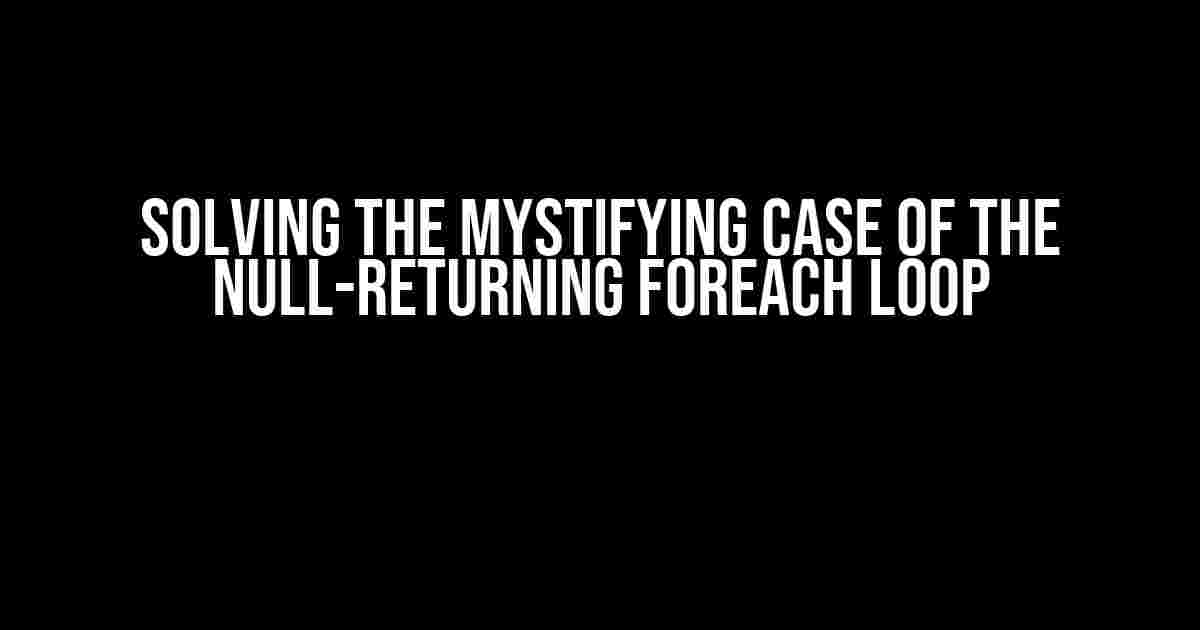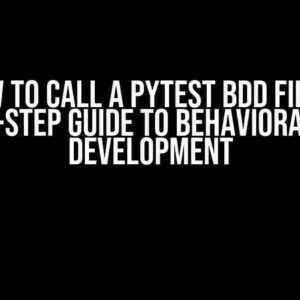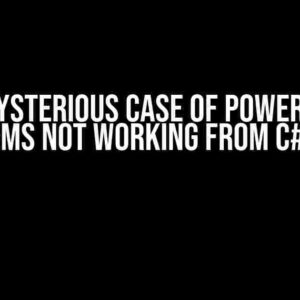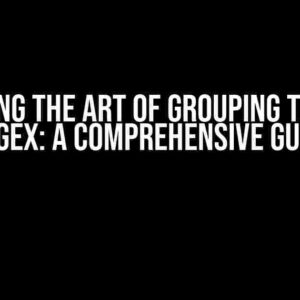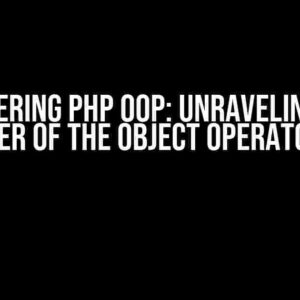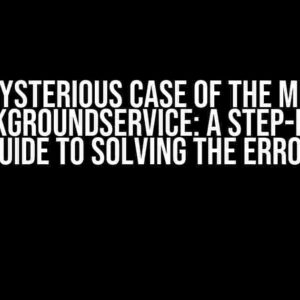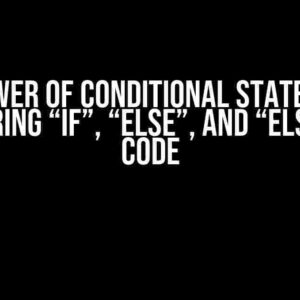Are you facing a frustrating issue where your C# foreach loop is returning null when iterating over a list of custom classes, despite the list being populated? You’re not alone! This phenomenon has left many developers scratching their heads, wondering what’s going on beneath the surface. In this article, we’ll delve into the possible reasons behind this anomaly and provide step-by-step solutions to get your foreach loop working as expected.
Understanding the Foreach Loop
Before we dive into the meat of the matter, let’s take a step back and revisit the basics of the foreach loop. A foreach loop is used to iterate over a collection, such as a list, array, or other types of collections that implement the IEnumerable or IEnumerator interfaces. The loop assigns each element in the collection to a local variable, allowing you to manipulate or access the properties of that element.
foreach (var element in myCollection)
{
// Do something with element
}
The Mysterious Case of the Null Return
Now, let’s assume you have a list of custom classes, and you’re trying to iterate over it using a foreach loop. However, instead of getting the expected output, you’re getting null references. You’ve checked that the list is not empty, and you’re confident that the custom class is properly defined. So, what’s going on?
Possible Causes
There are several reasons why your foreach loop might be returning null, even when the list is not empty. Let’s explore some of the most common causes:
Solutions and Workarounds
Now that we’ve identified the possible causes, let’s dive into the solutions and workarounds to get your foreach loop working as expected:
Solution 1: Check for Nullable References
If you’re working with C# 8.0 or later, ensure that you’re properly handling nullable references. You can do this by:
foreach (MyCustomClass? element in myList)
{
if (element != null)
{
// Do something with element
}
}
By using the nullable reference type (`MyCustomClass?`), you’re telling the compiler to allow null references. The `if` statement inside the loop checks for null values before attempting to access the properties of the element.
Solution 2: Implement Default Constructors
Make sure your custom class has a default constructor (i.e., a constructor with no parameters). This will allow the compiler to create an instance of the class:
public class MyCustomClass
{
public string Property1 { get; set; }
public int Property2 { get; set; }
public MyCustomClass() { } // Default constructor
}
Solution 3: Properly Initialize Objects
When creating instances of your custom class, ensure that you’re initializing the objects properly:
MyCustomClass obj = new MyCustomClass
{
Property1 = "Some value",
Property2 = 42
};
Solution 4: Initialize and Populate the List
Make sure the list is properly initialized and populated:
List<MyCustomClass> myList = new List<MyCustomClass>
{
new MyCustomClass { Property1 = "Value 1", Property2 = 1 },
new MyCustomClass { Property1 = "Value 2", Property2 = 2 },
new MyCustomClass { Property1 = "Value 3", Property2 = 3 }
};
Solution 5: Check Property Getter/Setter Implementations
Verify that the properties of your custom class have correct getter/setter implementations:
public class MyCustomClass
{
private string _property1;
public string Property1
{
get { return _property1; }
set { _property1 = value; }
}
private int _property2;
public int Property2
{
get { return _property2; }
set { _property2 = value; }
}
}
Additional Tips and Tricks
Here are some additional tips and tricks to keep in mind when working with foreach loops and custom classes:
if (myList.Any(x => x == null)) { throw new InvalidOperationException("List contains null references"); }try { foreach (var element in myList) { // Do something with element } } catch (Exception ex) { Console.WriteLine($"Error: {ex.Message}"); }for (int i = 0; i < myList.Count; i++) { if (myList[i] == null) { continue; // Skip null references } // Do something with myList[i] }
Conclusion
In this article, we’ve explored the possible causes and solutions for the mysterious case of the null-returning foreach loop. By following the tips and tricks outlined above, you should be able to identify and fix the issue in your code. Remember to check for nullable references, implement default constructors, initialize objects properly, and ensure the list is initialized and populated. Happy coding!
| Solution | Description |
|---|---|
| Solution 1: Check for Nullable References | Use nullable reference types and check for null values within the loop. |
| Solution 2: Implement Default Constructors | Ensure your custom class has a default constructor (i.e., a constructor with no parameters). |
| Solution 3: Properly Initialize Objects | Initialize objects properly when creating instances of your custom class. |
| Solution 4: Initialize and Populate the List | Make sure the list is properly initialized and populated. |
| Solution 5: Check Property Getter/Setter Implementations | Verify that the properties of your custom class have correct getter/setter implementations. |
By following these solutions and additional tips, you’ll be well on your way to resolving the null-returning foreach loop issue and writing more robust, error-free code.
Frequently Asked Question
Get the inside scoop on resolving the pesky issue of C# foreach on a list of custom class returning null when the list is not empty!
Why is my C# foreach loop returning null when iterating over a list of custom class objects?
This issue often occurs when the objects in the list are not properly initialized or are set to null. Make sure to initialize each object in the list and that none of them are null. You can also try using a debugger to inspect the list and see if it contains any null values.
How can I troubleshoot this issue and find the root cause?
To troubleshoot, set a breakpoint before the foreach loop and inspect the list in the debugger. Check the Count property of the list to ensure it’s not empty. Then, iterate over the list using the debugger and check each object for null values. You can also use the Debug.WriteLine method to output the contents of the list to the console.
What if I’m using a LINQ query to populate the list, could that be the issue?
Indeed! If you’re using a LINQ query, it’s possible that the query is not executed yet, and the list is still empty. Make sure to call ToList() or ToArray() to execute the query and materialize the list. This will ensure that the list is populated before you iterate over it.
Can this issue occur if I’m using a lazy-loaded list or a proxy class?
Yes, it’s possible! If you’re using a lazy-loaded list or a proxy class, the objects in the list might not be fully initialized until you access their properties. This can cause the foreach loop to return null. Try accessing the properties of the objects in the list before iterating over them to ensure they’re fully initialized.
Are there any best practices to avoid this issue in the future?
To avoid this issue, always initialize your objects before adding them to the list. Use null checks to ensure that objects are not null before iterating over them. Consider using a tool like Resharper or Roslyn to help you identify potential null reference issues in your code. Additionally, following best practices like the Null Object Pattern can also help you avoid null references.

